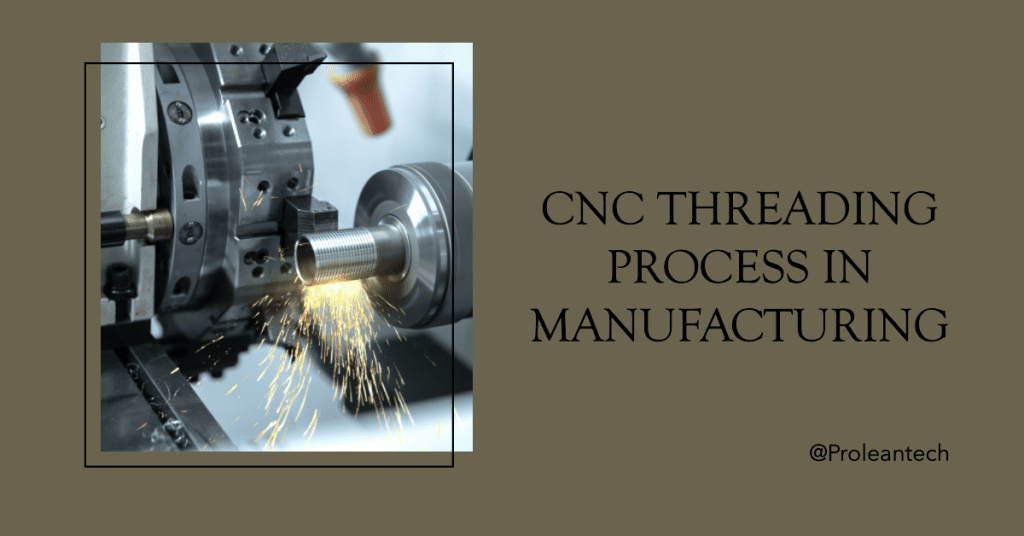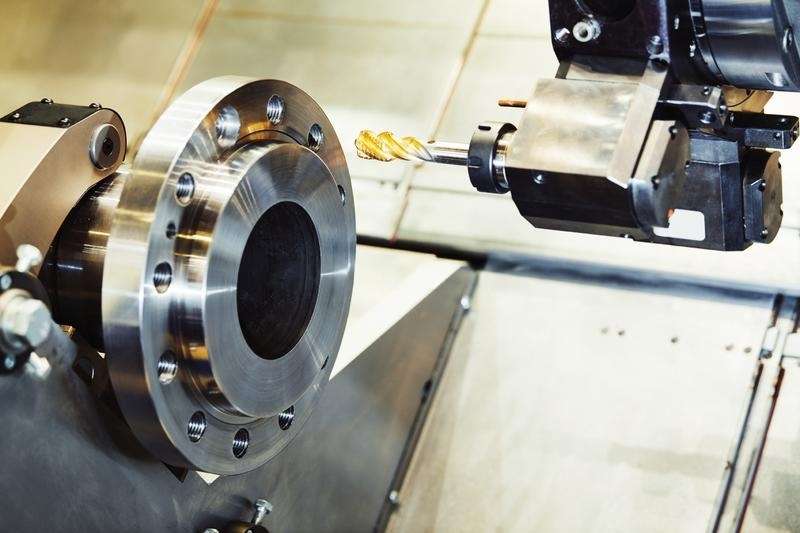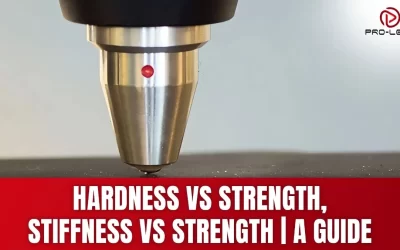
Thread manufacturing is a vital cog in the machinery of numerous industries, enabling the assembly of complex products and intricate designs. Whether in the automotive, aerospace, or electronics sector, threads form the backbone of many components, ensuring their optimal functionality and efficiency. Among the many methods of thread manufacturing, CNC threading stands out for its superior precision, versatility, and automation.
CNC threading is a computer-controlled process that leverages the capabilities of CNC machines to produce internal and external threads. The process, governed by computerized commands, enables manufacturers to produce threads with unmatched accuracy and consistency, thereby significantly enhancing the quality and performance of threaded parts.
In this article, we delve deeper into the intricacies of CNC threading, exploring its process, benefits, applications, and challenges. We also shed light on how Prolean’s CNC Threading service is harnessing the power of this technology to deliver top-notch threading solutions.
What is CNC Threading?

CNC Threading is a precise and automated process of creating threads on a workpiece using CNC machines. CNC, or Computer Numerical Control, refers to the automation of machine tools by means of computers executing pre-programmed sequences of commands. CNC threading can be used to create both internal threads (like those found in nuts) and external threads (like those on bolts).
The Key components involved in the CNC threading process include;
- CNC Machine: The CNC machine is the heart of the threading process. It can be a lathe, mill, or turning center, depending on the type and specifications of the thread to be produced.
- Cutting Tool: The cutting tool is used to remove material from the workpiece to form the thread. The tool’s shape and size depend on the thread’s specifications.
- Workpiece: This is a piece of material, such as metal or plastic, that is being threaded.
- CNC Program: The CNC program contains the instructions that the machine follows to create the thread. It is created based on the thread’s design and translated into G-code, the language that CNC machines understand.
- CAD/CAM Software: CAD (Computer-Aided Design) software is used to design the thread, and CAM (Computer-Aided Manufacturing) software is used to convert this design into a CNC program.
- Controller: The controller is part of the CNC machine that interprets the CNC program and controls the movement of the machine and cutting tool.
- Coolant: Coolant is often used during the threading process to reduce heat and friction, which can affect the quality of the thread.
Steps Involved in CNC Threading Process
CNC threading is carried out in a series of steps, each crucial to the successful creation of accurate and consistent threads:
Step1: Designing the Thread
In the initial stage, the design process of the thread begins. The thread’s specifications, including its size, pitch, depth, and form, are carefully planned out and visualized using CAD (Computer-Aided Design) software.
The CAD software helps to create an accurate 3D model of the thread. In this phase, parameters such as thread dimensions, tolerances, the number of threads per inch (TPI), and other necessary specifications are decided. This digital blueprint is essential for the next step.
After the thread design is finalized, it is converted into a language that the CNC machine can understand. This is achieved through the use of CAM (Computer-Aided Manufacturing) software. The CAM software translates the CAD design into G-code, a programming language for CNC machines. This G-code contains all the necessary instructions for the machine to follow to create the thread.
Step2: Setting Up the CNC Machine
Once the G-code is ready, the CNC machine has to be prepared for the threading operation. This involves setting up the right cutting tools for the job, ensuring that they match the thread’s size and type.
The cutting tool, often a single-point threading tool, is securely mounted onto the machine, and its position is calibrated. The workpiece is also mounted onto the machine and aligned correctly. The CNC machine’s spindle speed, feed rate, and cutting speed are set according to the material of the workpiece and the thread specifications.
Step3: Executing the CNC Program
With the machine setup complete and the G-code ready, the threading operation can now begin. The CNC program, containing precise instructions for every movement of the cutting tool, is executed.
The CNC machine, guided by these commands, controls the cutting tool’s motion to cut threads into the workpiece with remarkable precision. This process is automated, with the machine following the preprogrammed instructions to the letter, ensuring consistent and accurate thread creation.
Step4: Inspecting the Thread
After the threading process is complete, it’s essential to inspect the threads for accuracy and quality.
This inspection can involve visual checks, measurement with thread gauges, or more advanced methods such as coordinate measuring machines (CMMs) or optical comparators. The inspection ensures that the threads meet the predetermined specifications and are free from defects.
If the threads do not meet the required standards, the CNC program or machine setup may need to be adjusted. This feedback loop is crucial for achieving consistent quality in CNC threading.
Advantages of CNC Threading
CNC threading brings a plethora of benefits to the manufacturing table, making it a preferred choice for many industries. Here are some noteworthy advantages:
- High Precision and Consistency: CNC threading offers unparalleled precision and repeatability, ensuring each thread is cut to exact specifications.
- Versatility: CNC threading can handle a variety of materials and thread types, accommodating both internal and external threading.
- High Productivity: Due to automation, CNC threading can operate continuously, significantly boosting productivity levels.
- Reduced Waste: The precision of CNC threading leads to less waste material, contributing to cost-efficiency and sustainability.
Applications of CNC Threading
CNC threading finds its use in numerous industries due to its precision and versatility. Here are a few key applications:
| Industry | Application |
|---|---|
| Automotive Industry | Creating threaded components like engine parts, gearboxes, brake systems, and more. |
| Aerospace Industry | Creating high-precision components that must meet stringent safety and performance standards. |
| Electronics Industry | Creating threads in the small components of electronic devices, including computers and smartphones. |
| Medical Industry | Producing threads in surgical instruments and medical equipment, where precision is paramount. |
| Construction Industry | Creating threads in various construction components, such as steel beams, rebar, and fasteners, ensuring the structural integrity of buildings and infrastructure. |
Challenges in CNC Threading and How to Overcome Them
While CNC threading offers multiple benefits, it’s not without its challenges. However, these can be mitigated through proper understanding and appropriate measures.
- Machine Programming Errors: Incorrect CNC machine programming can lead to thread defects. Hence, it’s crucial to ensure accurate programming according to the thread specifications.
- Tool Wear: Continuous threading can lead to tool wear, affecting thread quality. Regular inspection and timely replacement of tools can help maintain high-quality threading.
- Material Issues: Certain materials may pose challenges during threading due to their hardness or brittleness. Using appropriate cutting speeds, feeds, and coolants, as well as choosing the right tool material, can help overcome these issues.
Prolean’s CNC Threading Service: Unmatched Precision and Quality
At the heart of Prolean’s offerings is our exceptional CNC Threading service. Leveraging cutting-edge CNC machinery and a team of seasoned professionals, we provide high-precision threading solutions across a diverse range of industries and applications.
Our services encompass both internal and external threading and can handle a variety of materials, including aluminum, steel, titanium, and various exotic metals. With a keen focus on precision and quality, we ensure our threading operations meet the most stringent specifications and standards.
Prolean’s CNC Threading service is a testament to our commitment to excellence. Our regular inspections, strict quality control measures, and meticulous optimization of cutting conditions ensure we consistently deliver threads of exceptional quality.
Conclusion
CNC threading, with its high precision, consistency, and versatility, has become an integral part of modern manufacturing. Understanding its intricacies, benefits, applications, and challenges is crucial to leverage this process effectively.
Prolean’s CNC Threading service embodies this understanding and goes the extra mile to deliver exceptional quality and precision, making it an ideal solution for all your threading needs.
FAQs
What is CNC threading?
CNC threading is a manufacturing process that uses computer-controlled machines to produce precise and consistent threads on workpieces.
What are the advantages of CNC threading?
CNC threading offers high precision and consistency, versatility, high productivity, and reduced waste.
What are the applications of CNC threading?
CNC threading is used in various industries, including automotive, aerospace, electronics, medical, and construction, to create threads in different products and components.
What are some challenges in CNC threading?
Some challenges in CNC threading include machine programming errors, tool wear, and issues with certain materials. These can be mitigated with accurate programming, regular tool inspection and replacement, and proper cutting conditions.
What materials can be threaded with CNC threading?
CNC threading can handle a wide range of materials, including aluminum, steel, stainless steel, brass, copper, titanium, and various types of plastic.
Can CNC threading be used for both internal and external threads?
Yes, CNC threading can be used for creating both internal and external threads.




0 Comments